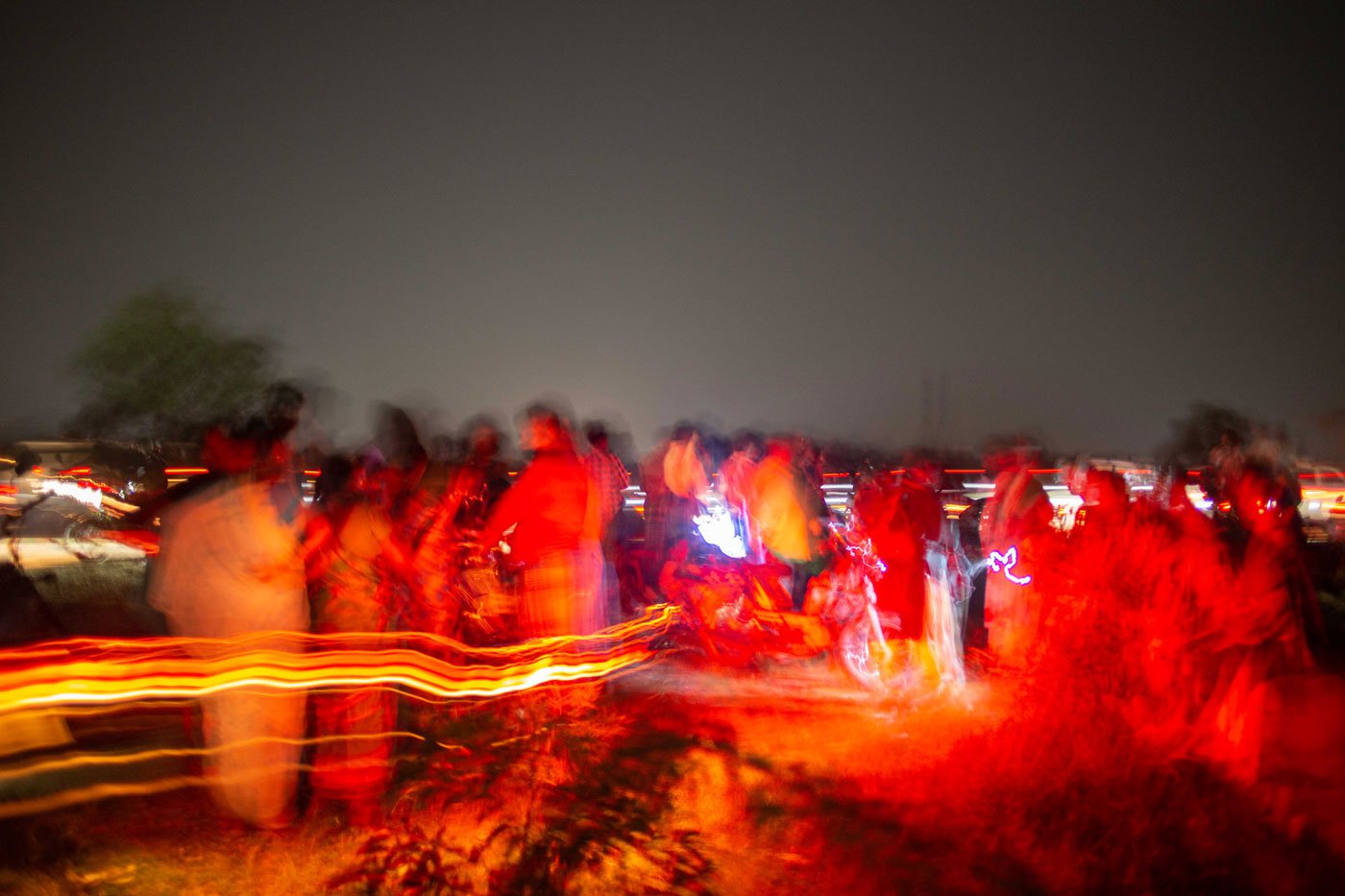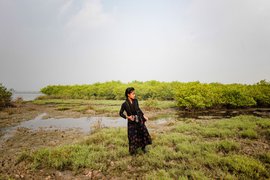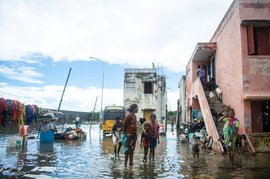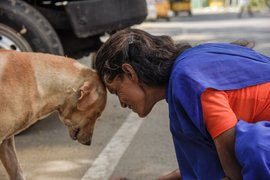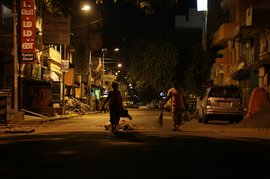When I arrived in Gandhinagar and Alagapuri, the villages were densely packed with a restless crowd. The two villages are separated by just a road in between. There was an overwhelming presence of police personnel and vehicles. The devastating news of the fire accident, claiming the lives of 14 workers at the Kanishka Fireworks Company in Sivakasi town had profoundly unsettled the community. Six deaths occurred in Gandhinagar village alone, and all were from the Devendrakulathan community (listed as Scheduled Caste in Tamil Nadu).
People were weeping on the streets for their lost loved ones. Some were on the phone, informing relatives in other towns and villages of Virudhunagar district.
After a while, the crowd began moving towards the crematorium, and I joined them. The entire village had turned out and was on its way to the crematorium to bid farewell to the six workers from the village who died in the accident on October 17, 2023. A firefighter in charge of removing the burnt bodies was explaining the difficulty in retrieving them for post-mortem.
At around 8:30 p.m., six ambulances finally arrived at the crematorium, and the crowd rushed towards them, erupting with cries. For a moment, I forgot my job; I was unable to take out my camera. In the darkness of the night, the crematorium was veiled, and the flying termites clustering around a light looked like the villagers gathered there.
The crowd withdrew as soon as the bodies were taken out – the smell of burnt flesh was unbearable. Some even vomited. The bodies were identified only because they came labelled with their names. As the crowd drifted away, the crematorium stood alone.


Left: An accident at the Kanishka Firecracker Factory in Sivakasi, took the lives of 14 workers. Right: People gathered at one of the victims of the fire, M. Balamurugan’s house


Left: Relatives and friends of the deceased walk towards the crematorium. Right: People continue to wait for the bodies to arrive even as it starts getting dark
M. Sandhya, a 14-year-old student, had dreamed of becoming a scientist. After losing her mother, Muneeswari, in the accident, she is now rethinking her dreams. Sandhya's mother had worked at the factory for the last eight years; she had worked overtime to fulfil her daughter’s needs. As a single parent, she gave her best, says Sandhya's paati (grandmother) who is looking after her. "I don't know how long my paati will be able to take care of me. She suffers from severe diabetes," said Sandhya.
Panchavarnam lost her husband in the tragic event. “The samples of fireworks that were kept outside caught fire,” she says. "Since I was sitting close to the exit, I escaped. But he couldn't come out due to the smoke."
She shows me the blisters and scratches she got while escaping. "Usually, when customers buy in large quantities, they prefer to see a sample. They are supposed to go at least a kilometre away from the factory if they plan to test the sample. But on the day of the incident, they tested the sample near the factory premises. The sparks from the test flew everywhere – they fell on the factory roof and from there on to the crackers they were assembling. The whole room caught fire within seconds, and of the 15 workers, 13 got caught in the fire. The three who escaped with third-degree burns were in the toilet at the time of the accident. If not, they too would not have survived. When they ran out, their sarees were on fire," she recounted.
Panchavarnam and her husband Balamurugan's
income depends on the hours of manual labour they do. With their hard-earned
money, they've brought up a daughter who is in her first year of BSc Nursing,
and a son who has a diploma in ITI. While remembering her husband Balamurugan,
Panchavarnam said, "he was willing to go to any end to educate his
children." His daughter, Bhavani, said, "he always insisted on one
thing: education. He didn't want us to suffer like he did."


At 8:30 p.m., the first ambulance arriving (left) at the burial ground; it was followed by five more (right)


Left: The workers who passed away are identifiable by the numbers written on the cloth in which they are wrapped. Right: Grieving family and friends watch as bodies are unloaded from the ambulance
Now, after the fire and the subsequent hospital expenses, Panchavarnam and family are deep in debt. So far, she has had to have five surgeries due to complications in her kidney. She has been advised to take medicine that costs Rs. 5,000 a month. "We still haven't paid our daughter's college fees [Rs. 20,000]. We thought we could pay it from our Diwali bonus," she said. Even health check-ups are unaffordable for Panchavarnam; she says she has been passing her days eating tablets to keep her salt levels in check.
Bhavani is Balamurugan and Panchavarnam's younger child. The 18-year-old is still processing her father's death. "He took care of us so well, and he made sure we didn't do any chores in the house. He was the one who took care of everything in our home. Since our mother is sick, she can't clean and cook, and he would do it, and not expect me to." The siblings relied heavily on their father, and are struggling with his loss.
The government has handed out a compensation of Rs. 3 lakhs; they received the cheque at the collector's office. And the factory compensated them with Rs. 6 lakhs in October. Panchavarnam was confident they would help as both she and Balamurugan have been loyal employees, working at the fireworks company for the last 12 years.
Women and men in Gandhinagar village largely take up work as daily wage labourers either in agricultural fields or at the fireworks factory. This Panchavarnam’s family chose the latter option because the factory pays a bit more than the landlords who own the agricultural lands.
Their 19-year-old son, Pandiyarajan, has been paralyzed with fear and grief ever since he went to the spot of the accident. It has shaken him, says his sister. "I was the last one he [his father] called that day. He was calling to check if I had had my lunch. Half an hour later, his co-employee called me to inform me about the incident. I hurried to the spot, but they didn't let me in. Only after reaching the hospital, I found out that he wasn't alive anymore," says Pandiyarajan.
"We don't know how to live anymore. We are
ready to do whatever our mother asks of us. Even if she asks us to commit
suicide, we will. How long will our relatives provide us with shelter and
care?" asks Bhavani.


Left: People use their mobile torches to prepare the space for cremation. Right: All the six bodies were cremated together

The pyres burn into the night, long after relatives and friends have left
Tamilselvi was 57 when the fire took her life. She had joined the fireworks factory 23 years ago and used to earn Rs. 200 a day, which gradually increased to Rs. 400 a day.
T. Easwaran, her youngest son said, "My father passed away when I was just two years old. Since then, my mother has provided for my elder brother and me.” He and his brother are both graduates. “I pursued Computer Science, while my brother earned a BSc," he says.
Tamilselvi’s older son is now a police officer working in Tirupur. "She worked her entire life for the betterment of her son, but she is no longer to witness the heights that they are going to reach," said her relatives.
Kuruvamma who survived the fire says that the daily wages of around Rs. 250 are for work drying the chemical substances, rolling in paper and stuffing them with explosive chemicals, and finally tied together. The money is handed to them only at the end of the week. They do not get regular hikes, instead, they get a bonus. They are eligible for a bonus of Rs. 5,000 every six months contingent upon them working at the factory without leave.
Many women in this village work in these
factories despite the harsh conditions because most families rely on their
income. The late Kuruvammal,
who succumbed to her burns in the fire, is one such woman who carried
her family on her shoulders. Her husband, Subbu Kani has partially lost sight in a similar
fire accident while working with borewells. He can no longer earn a daily wage,
and now with Kuruvammal gone,
the family of three now is on the verge of collapsing. "She was my light
who showed me my path after I lost my sight," says Subbu Kani, with teary eyes.

Balamurugan is survived by his wife, Panchavarnam and their children, Pandiarajan and Bhavani


Left: Balamurugan used to take his family for tours. This photo was taken on a trip to Kanyakumari. Right: A photo of Balamurugan in Bhavani's phone
Another victim of the terrible fire was Indrani, who suffered from severe knee pain, and standing for more than 30 minutes would be almost impossible for her. But she pushed herself to work in order to take care of her husband, who suffered from epilepsy, and her children. Their family of four had been living in a one-room house and they had added another room after borrowing money.
"My mother and I were planning to settle our debts in the next six months. She was worried about my marriage too. Who would want to marry a poor girl with an epileptic father and a sick mother?” says Kartheeswari, Indrani’s daughter. She is planning to write Group 4 exams for a government job this year. “I can't afford to pay the fees that coaching centres demand," she added.
The family suffered another tragedy when the father passed away in December 2023. While tying a Christmas star, he slipped and fell. It was a fatal fall and now young Kartheeswari is all alone with family debts and her Group 4 ambition.
Some of the women from the village like
Guruvamma used to work at a match factory, getting paid only Rs. three for
cutting and packing 110 matchboxes. The women realised that they were exploited
for very low wages and they took a collective decision to move to the fireworks
factory.


Left: The a ccount book of Muneeswari’s weekly wages. Her weekly income never reached Rs.1,000. Right: Sandhya with Muneeswari in a photo that they took in Tiruchendur


Left: A letters written by Sandhya to her mother Muneeswari who died in the accident. Right: Sandhya with her grandmother
Agriculture is the only other option for employment in this village, but it is no longer available as drought and famine have rendered the agricultural lands uncultivable. In some areas, even if there is enough groundwater, landlords do not pay fair wages. So, women like Kuruvamma work in the factory but also rear sheep and cattle. However, there too, they face multiple challenges as there are no grasslands for the cattle due to drought.
The only other alternate employment available to the villagers is MNREGA, referred to as noor naal vellai (100 days of work) in the state. T. Mahendran, who lost his wife, Thangamaalai said that it would be beneficial for the women in the village if the government were to extend the 100 days working scheme to all 365 days.
Mahendran says that fireworks companies in the area don't have a proper licence and he alleged that government officials who are supposed to monitor them don’t dare suspend these factories for more than six months. As a result, a factory reopens again in the seventh month. This is not the first accident: Eight Dalit children died in Krishnagiri in October 2023. Read: ‘Every house is like a graveyard’
This
heart-wrenching incident, marked by grief, loss, and the harsh realities faced
by the survivors, reflects the urgent need for both societal and governmental
support. The stories of those affected underscore the pressing demand for
improved working conditions, safety measures, and a comprehensive social safety
net. It is a stark reminder that behind every tragic incident, there are human
lives with dreams, struggles, and devastating loss of those left behind.


S.Kuruvammal (left), died in the accident. Her husband, Subbu Kani, has problems with his eyesight and it was Kuruvammal who worked at the factory to feed the family


Left: Indrani died in the accident. This video was taken by her daughter Kartheeswari, when she went along with her mother to the factory on one of her holidays. Right: Indrani was her husband, Muruganandham's sole caregiver. His health condition worsened after her death. In December 2023, he slipped down from a chair and died


Left: The sari worn by Indrani before her death. Right: Kartheeswari standing in a small room built by Indrani

S. Murugayi was burnt but survived the accident

Thangamaalai’s husband is looking for her photograph. She died in the accident

Muthulakshmi's husband holding the last photo they took together

'I believe this photo story about the accident would bring in some light in Kartheeswari’s life,' says photographer Palani Kumar
